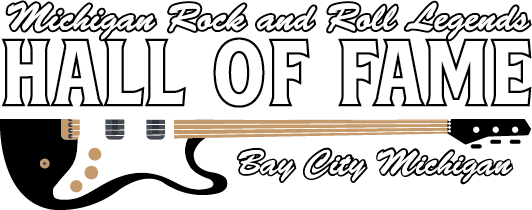Even though it was one of Michigan's largest and most uniquely designed teen clubs, the Mummp was in operation for just under two years. Located in the Northland Center, the nation's first large-scale shopping mall, the venue was originally the home of a summer stock theater. Encased in a large tent under a futuristic, Buckminster Fuller-designed geodesic dome and featuring a revolving stage that presented many of the finest Michigan bands of the 1960s, the Mummp quickly became a hotspot for Detroit-area teens.
The unofficial opening of the Mummp on Saturday night December 10, 1966, was covered by the Southfield News. According to the paper, it drew a large crowd of teens to see the Jagged Edge, the Tidal Waves, Gino Washington, Tim Tam, and the Shy Guys perform. 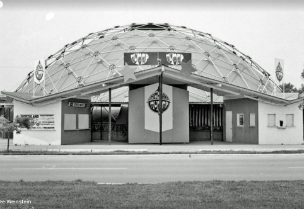 The Mummp
The Mummp
The geodesic dome housing the Mummp was part of the Northland Center shopping mall, a 159-acre site located near the intersection of M-10 and Greenfield Road. The idea for Northland came from an Austrian-born department store architect named Victor Gruen who wrote about it in a letter to J. L. Hudson's President Oscar Webber. The crux of Gruen's recommendation was that since many of the department store's customers were moving to the suburbs, Hudson's should develop its own commercial property and build a mixed retail shopping center that would diversify its business beyond retail into real estate development and commercial property management.
Gruen was hired to develop a 20-year plan for Hudson's suburban expansion. He proposed a ring of four shopping centers: Northland, Eastland, Southland, and Westland. All locations were on the the outer fringes of Detroit's borders where land was cheap and the potential for expansion was greatest. Northland was the first, and construction began in 1952. Gruen set about designing a new shopping experience that would include lavish landscaping in large brick planters, auditoriums, sculptures, fountains, and even a bomb shelter that could house 7,000 people in an emergency. 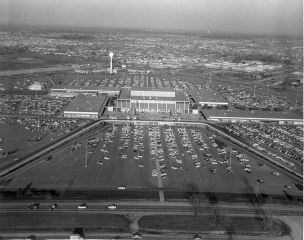 Northland Center
Northland Center
Northland Center opened with great fanfare in the spring of 1954. It was the first and the largest shopping center in the country in terms of square footage and number of retailers in one facility. A four-level, 475,999 square foot J. L. Hudson's store was situated in the center of the cluster-type mall, surrounded by five retail blocks, and seven open court areas. All enclosed structures were air-conditioned, another 1950s innovation.
The Wall Street Journal, Time, Newsweek and other publications dispatched reporters to cover its grand opening. Reviewers heralded Northland as the future of shopping in post-war America. An estimated 50,000 Detroiters passed through its doors each day for weeks after its opening, and in its first year the Northland J. L. Hudson's grossed $88 million.
The area surrounding and including Northland was incorporated as the city of Southfield in September, 1957. Improved access came in 1962 when the John Lodge Expressway was extended from Wyoming Avenue to 8 Mile Road. 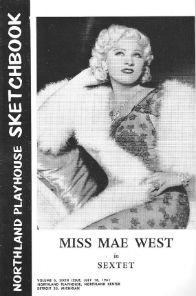 Mae West at Northland Playhouse
Mae West at Northland Playhouse
The Northland Playhouse, future home of The Mummp, was a 1,550-seat tent that opened on June 29, 1956. According to Billboard magazine, the theater was co-sponsored by the Kroger Company, and the grocery chain offered tickets to its customers at a 25% discount. After the tent was blown down by strong winds, a geodesic dome was constructed to cover it in 1957. Producer/director Ken Schwartz brought in some of the biggest names in the entertainment industry to perform there, including Zsa Zsa Gabor, James Coburn, Red Buttons, Cesar Romeo, Yvonne De Carlo, Margaret O'Brien, and Mae West.
Despite the quality of the productions at the Northland Playhouse, the lack of air conditioning, pesky mosquitos, and declining attendance resulted in its closing by the mid-1960s. Enter Hy Weinstein, owner of Weinstein Jewelers in downtown Detroit. Weinstein's oldest son, Todd, said of his father, "He was an entrepreneur and, since his four kids loved music, he decided to invest in a musical venue that would appeal to them and enable him to keep tabs on them as well."
When Hy Weinstein drove his family to see the geodesic dome that he planned to rent from the Northland Corporation, his oldest daughter, Cheryl, declared that the structure looked like "a mump", her term for a pimple. Hy thought that it made for an interesting name and simply added an extra 'm' to come up with 'Mummp' as his new teen club moniker. 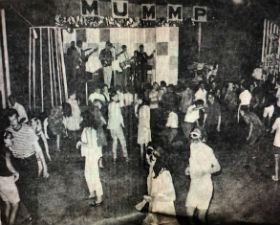 Inside The Mummp
Inside The Mummp
Weinstein and his partner, Bernie Adelson, installed both heating and air conditioning in the tent so that the club could operate all year round. Weinstein also designed a revolving stage so that as one band was finishing its set, the stage would revolve to present the next band to perform. Todd Weinstein, who along with his younger brother, Lee, did the venue's light shows, recalled that one side of the Mummp's stage had dayglow colored strips and the other side was painted with dayglow colors so that it would produce a psychedelic effect as one band was finishing its last song and the next band began playing its opening number.
The Mummp was a non-alcohol club for young adults between the ages of 16 and 21. It promised live entertainment that offered bands, dancing, go-go girls, and guest stars. The club was open Thursdays and Sunday from 8:00 p.m. to 12:00 p.m. and Fridays and Saturdays from 8:00 p.m. to 1:00 a.m. The club also offered matinees on Saturday and Sunday afternoons from 1:00 p.m. to 5:00 p.m. for young people, ages 11 to 15. 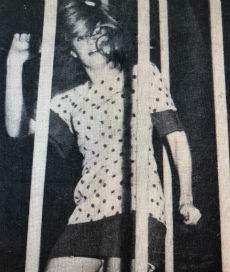 Gayle Saperstein - Mummp go-go girl
Gayle Saperstein - Mummp go-go girl
The Mummp menu from 1966 offered an array of non-alcoholic kiddie cocktails under the heading "Exoque Drinks". The choices (spelled as follows) included a Stinger, Zombi, Brandy Alexander, or Screw Driver for $.50; a Daquiri, Brave Bull, Crème Dementhe, and Crème Decocoa for $.45; and a Rum Collins, Cherry Passion, Lemon Passion, Whiskey Sour, or Brandy Sour could be purchased for $.40. There was also a "near" Beer for $.50, and Champagne by the bottle cost $1.25.
For those not pretending to drink alcohol, there were Chocolate or Cherry Cokes, and Cherry Sprites for $.25, or straight Coke or Sprite for $.20. Salty snacks like chips, pretzels and Fritos went for $.10.
The Mummp's official grand opening ran from December 15-18 and, according to its newspaper ad, was hosted by Robin Seymour of CKLW-TV. It was headlined by Mitch Ryder (backed by the Motor City 5), the Jagged Edge (with its "psychosomatic sound"), the Rationals, the Shy Guys, the Pleasure Seekers, the Talismen, the Valumes, and the Sandpipers - plus "20 more great live bands"! 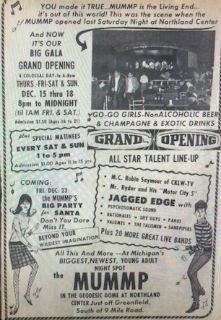
The grand opening ad teen also hailed the teen club's heating system for the December opening with "1,000 BTU's to keep Mummp the hottest spot in town."
The grand opening drew an estimated crowd of 1,600 teens. Mummp owner Hy Weinstein was quoted as saying, "The crowds exceeded our wildest hopes. It was just unbelievable. They were lined up an hour ahead of opening time, and they just never stopped coming." Robin Seymour, host of Swingin' Time on Channel 9 in Detroit and the evening's Master of Ceremonies, termed the opening, "The biggest and most enthusiastic greeting I've ever seen a young audience give a new club."
The Mummp opened while both Todd and Lee Weinstein were attending Oak Park Junior High school in suburban Detroit. Todd was a classmate of future lawyer Geoffrey Fieger, and Lee's classmates included David Weiss and Don Fagenson. Years later, Weiss and Fagenson would adopt the stage names David Was and Don Was and form the group Was (Not Was). Lee was also in the same grade as Doug Fieger who would go on to form the Detroit band Sky and, later, top the charts with "My Sharona" as a member of The Knack. "We loved the fact that our father ran the Mummp teen club," Todd Weinstein recalled. "Lots of our friends came and danced all night. Many of them were musicians and played there during the battle of the bands," Weinstein said. "Robin Seymour of CKLW and Scott Regan of WKNR were big factors in bringing in bands to play at the Mummp." 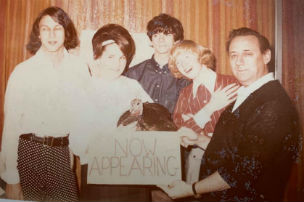 Hy Weinstein (R) with the Jagged Edge
Hy Weinstein (R) with the Jagged Edge
Bob Seger & The Last Heard, the Scot Richard Case (SRC), the Detroit Vibrations (Frijid Pink), and the Woolies were among the top Michigan bands to also play the club. Todd Weinstein recalled that the Amboy Dukes showed up one day for one of the Mummp's open auditions. "They were great," Weinstein remembered, "and they became one of the regulars, along with the Jagged Edge and SRC, bands that appeared at the club almost every weekend." Todd said that because the Amboy Dukes basically became the house band at the Mummp, he got to know Ted Nugent back in the day. He recalled that the guitarist and lead vocalist John Drake even had dinner at the Weinstein home.
"The Band of Gold from Detroit was another band that played often at the Mummp. They were special," Todd Weinstein recalled. "My father started to manage them and set up his own label to record the group." The Band of Gold released one single on the Mummp label in 1967, "Like A Hurricane" backed with "Her Love". Listen to "Like A Hurricane" at https://www.youtube.com/watch?v=Q7USTynIzVY 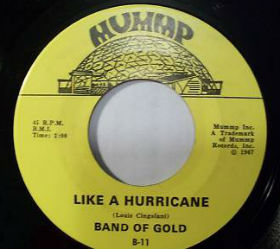
Hy Weinstein and Bernie Adelson opened a second non-alcoholic teen club in Brighton, Michigan, called the Bypass. It was smaller than the Mummp, but it offered the same amenities and many of the bands that played at the Mummp were also booked at the Bypass, and the Weinstein brothers worked there as well. Hy Weinstein loved running the two clubs. Because they were so successful, he had offers for the clubs, but he wouldn't sell. Acccording to his daughter Cheryl, it was the happiest thing he had ever done; and he was enjoying it too much to let it go. The Mummp had even been featured, accompanied by a color photo, in the March 17, 1967, issue of Life magazine.
The Detroit News also covered the Mummp in a somewhat sensationalized 1967 column by Doc Greene that dealt with both the Northland teen club and the Grande Ballroom, which had opened two months before the Mummp on October 7, 1966. Greene reported that admission to the Mummp was $1.50. He then interviewed Bernie Adelson who told him that the Mummp employed 18 security guards who searched every teen coming into the venue, including matrons who searched the girls. According to Adelson they were looking for "switchblades, nail files, booze, goofballs ... that sort of thing." 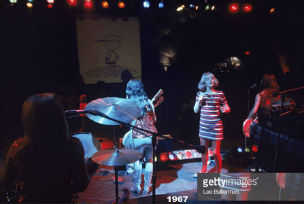 Life magazine's Mummp photo
Life magazine's Mummp photo
When Greene asked if the teens minded being searched, Adelson replied, "No. We explain that we can't have these kinds of things on the premises. They are mostly good kids. They don't mind, and they feel better when they know that nobody has got anything," Adelson said. The Jagged Edge was playing the evening Greene visited, and he noted that the Mummp rules were printed on a board. The big one was: Once you leave, you can't get back in. "They can't go out to the car and have some booze or something, or have a drink and then come back," Adelson told Greene. "I can't afford trouble. We don't take any chances."
The Grande, on the other hand, seemed to Greene to be much more relaxed. Patrons had to be over 17 years of age and the cost was $2.50 per person. There were fewer security guards and no posted rules. The MC5 were playing the evening Greene visited the Grande. When he asked about any problems at the club, one of the security guards answered, "No, we never have any trouble to speak of." "No one was searched," owner Russ Gibb told Greene. "We work on the theory that everyone is all right, and mostly they are," Gibb said. "It's wrong to assume that a kid is bad." 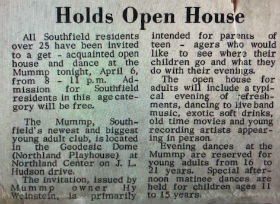
In comparing the Mummp to the Grande during the early days of both clubs, a teenager told Greene: "They've both got something. What the Mummp's got is better and more bands. You can have more fun at the Grande. They treat you better." It might have been nice if Greene would have interviewed a teen at the Mummp as well, but that was not the case.
Perhaps in an attempt to set aside to any parental fears conjured up by Doc Greene's column, Hy Weinstein organized a free get-aquainted open house and dance at the Mummp for all Southfield residents over 25 years of age from 8:00 to 11:00 p.m. on April 6th. The event was primarily intended for the parents of teenagers who would like to see where their children go and how they spend their evenings. The open house for adults included a typical evening of refreshments, dancing to live band music, exotic soft drinks, old-time movies, and young recording artists appearing in person.
The open house idea seemed to work for the Mummp, and both the teen club and the Grande Ballroom continued to do well. Todd Weinstein and his friends loved going to both venues and said this about the scene a recent interview, "We all felt it was a gift to be a part of such an amazing time living in the Motor City with all the music around us. You couldn't recreate such a time." 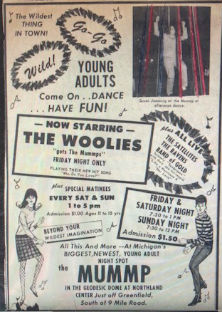
That time seemed to change rather quickly, however, starting with the Detroit riot in July of 1967 that left 43 dead, 1,189 injured, over 7,200 arrests, and more than 2,000 buildings destroyed. "Everything changed after the riot", Todd Weinstein recalled. "It had a big impact."
By 1968, drug use had also become more prevalent among young people, and the drugs were much more difficult to keep out of the clubs than alcohol. According to Weinstein, it was the drug issue that brought an end to the Mummp. "The closing of the Mummp in 1968 happened because the Northland Corporation did not want any bad press from the drugs that were now all around the teen clubs and, as a result, they would no longer let my father rent the building," Weinstein recalled. "My father was very upset because he loved creating a place for teens to go and meet each other around music."
Following the closing of the Mummp, the geodesic dome and the tent inside were removed. During Northland's early years, there was a larger consumer base and very little to compete with it. Soon, competition from the Somerset Collection, the Fairlane Town Center, the Oakland Mall, and the Twelve Oaks Mall contributed to the migration from Northland. Northland failed to change with the changing needs and expectations of consumers and was slowly replaced by more upscale shopping alternatives. In its later years, there were a few violent crimes and shoplifting was rampant, which further contributed to its decline.
Throughout the 1980s and 1990s, Northland had a turnover of major tenants. In December of 2008, the shopping center was sold to a New York Corporation, but after they defaulted on a $31 million payment, Northland was placed in receivership. The mall was closed for good in March, 2015. Later that year, the city of Southfield purchased it for $2.5 million with plans to demolish most of the property. 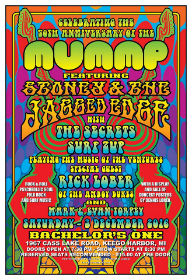 Dennis Loren's anniversary poster
Dennis Loren's anniversary poster
Although the Muump has been gone for over 50 years, it remains in the memories of those, now in their 60s and 70s, who patronized the club. Some of those who remembered its glory days organized a 50th anniversary celebration of the Mummp on December 3, 2016, at a venue in Keego Harbor, Michigan. The event was headlined by Stoney & The Jagged Edge and featured performances by the Secrets and Surf Zup.
Dennis "Dee" Kiraga is the bassist in The Secrets and, like Dave "Stoney" Mazur, he played at the Mummp during the 1960s. "We started a band called the Rockin' Levis in 1964, which was a take on the Swinging Blue Jeans from Liverpool, England; and we stayed together for a few years while we were all attending St. Florian's High School in Hamtramck," Kiraga said.
"The band played a lot of jobs during that time, and we liked to hang out at the Northland Mall. When we heard about the Mummp opening in late 1966, we went to the club and thought it was a great place," Kiraga recalled. "The building looked phenomenal, and we were really impressed with the interior, especially the go-go girls dancing in cages." 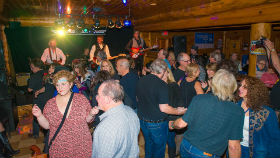 The Secrets at Mummp reunion
The Secrets at Mummp reunion
"The Rockin' Levis played there a couple of times - once on a Saturday afternoon and once at night; but I don't remember how we ended up getting booked there," Kiraga said. "It was the coolest nightclub we ever played at. While we were on stage playing, the girls were dancing in cages - we were pretty enthralled by that. It was also the only times we played on a revolving stage."
The Secrets, formed about twelve years ago, got involved in the Mummp reunion after Kiraga happened to run into Lee Weinstein at a friend's birthday party. Weinstein mentioned the upcoming reunion, and when Kiraga told him that he had played there with the Rockin' Levis, Weinstein remembered the band.
Weinstein also revealed that Stoney Mazur and the Jagged Edge was the reunion headliner and that Stoney was putting the musical line-up together. The Jagged Edge was one of the main attractions at the Mummp. They were older, friends with the Weinsteins, and appeared there quite often. The Jagged Edge also played the Grande Ballroom regularly and had the opportunity to open for The Doors at Cobo Hall in 1968. 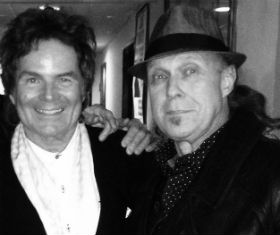 Dennis Kiraga and Stoney Mazur
Dennis Kiraga and Stoney Mazur
After going to see the Secrets play at the Northern Lights Lounge in Detroit, Mazur added them to the list of entertainers. "The Mummp anniversary was a great time and all of the tickets to the event were sold out," Kiraga said. "Surf Zup opened, and everyone danced from that point on." One of the songs the Secrets played that night was "Paint It Black". Kiraga told the audience that it was the same song that he had played with the Rockin' Levis at the Mummp 50 years earlier.
"Nothing is ever really lost to us as long as we remember it" - L.M. Montgomery
